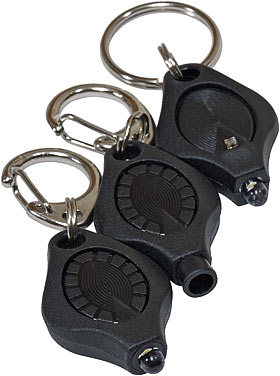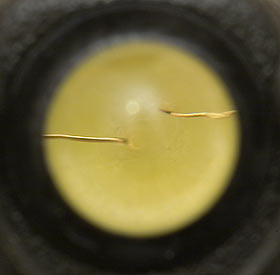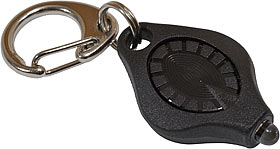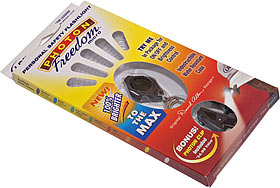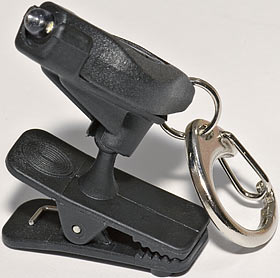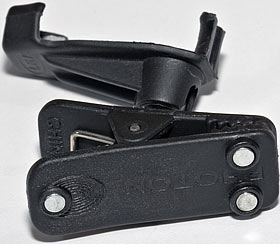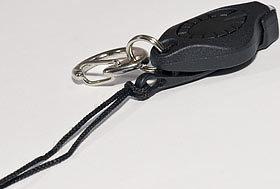
Photon Freedom Micro and Micro-Light II
(Newer! Brighter! Better!)
Review date: 13 August 2005.
Last modified
03-Dec-2011.
Itsy bitsy teeny LED keyring lights are very, very useful. Everybody should have one. And, given that the going price for five or more of them on eBay has been hovering around $US1 delivered per unit for some time now, it's not difficult to get yourself a lifetime supply.
(They're all powered by lithium coin cells with a ten year shelf life, so you needn't worry about having a few sitting in a drawer for years on end.)
The one dollar lights are, of course, not products to which you'd want to trust your life. Generally pretty reliable, great presents for anybody old enough that they won't try to inhale them, but you can't expect a reliable switch, water resistance or top-flight brightness for this kind of money.
There are plenty of manufacturers who'll happily sell you fancier, and much more expensive, keyring lights. Even the big brands have 'em these days. But if there's ever going to be a Kleenex, a Hoover, a Xerox of keyring lights, it'll be made by Laughing Rabbit Incorporated.
Fortunately, LRI's signature product is the Photon Micro-Light, commonly known as the Photon, so you don't have to sound as if you're talking about Dylan when you refer to it.
I've written about Photons and their relatives and competitors on several previous occasions, but time is marching on. Now there's not just the original Photon I (plain squeeze light, no electronics), II (adds a slide switch so you can lock it on) and 3 (microprocessor controlled with multiple light levels and further fanciness); no, now there's the Freedom Micro, too.
And it's brighter.
And there's more.
New(ish) faces
Here are three current-model Photons. From left to right (or bottom to top, if you prefer), there's a white-LED Freedom Micro (which looks the same as all of the other normal Micros), an ultraviolet Freedom Micro, and a white Photon II.
I'll get to the UV oddity in a moment. First, the ones that most people buy.
There hasn't been a lot happening in the ordinary white LED market for a while now. Companies like Lumileds are forging ahead in the creation of super-powerful giant LEDs, but the standard 5mm models have stayed much the same.
Suddenly, though, Nichia had a brainwave and made white LEDs twice as bright.
Nichia invented blue LEDs (well, actually Shuji Nakamura did, while he was working for them), and the white LED was a natural follow-up. White LEDs are blue LEDs with a phosphor coating over the die that turns some of the blue into other colours to make up a, generally, rather nice smooth white containing a decent amount of the optical spectrum.
This isn't terribly efficient, though. The phosphor coating blocks a lot of light, and gives typical white LEDs a lumens-per-watt score that's only about as good as a decent halogen lamp - better than basic nitrogen-filled incandescent bulbs, but that ain't saying much. Coloured LEDs aren't incredibly efficient either, but they're a lot better than white.
Nichia's recent breakthrough made the substrate more transparent, which somehow makes the LED brighter. I was under the impression that the substrate was under the light emitting and reflecting layers of the LED...
...and these ones look like the usual puddle of yellow phosphor to me, so I'm not actually sure how this works. But whatever they've done, it unquestionably does work; for the same power input, Nichia's new "CS" series LEDs genuinely are about twice as bright as the old ones.
The actual brightness of keyring lights is a rather fuzzy figure, because the tiny batteries they run from are made to deliver microamps, not the tens of milliamps an LED wants. What this means is that pretty much all of these lights are impressively bright from fresh batteries, but get dimmer literally by the second, until the battery voltage has sagged enough that the LED current also drops to something the batteries find less terrifying.
The Freedom Micro and Photon 3 can be kinder to their batteries, because they both have adjustable brightness. The Photon III has a two-way squeeze switch, as I explain in my review of it; half of the switch does fancy microcontroller stuff, and the other half just turns the light on at full brightness.
The Micro has a one button interface, but it works really well - press once for full brightness, press and hold from off to ramp up brightness from minimum to maximum, press and hold from on to ramp down brightness from maximum to minimum. Keep holding the button after a full brightness ramp and you'll cycle through three different "safety beacon" flash modes, plus a Morse code SOS.
If you press the button several times in quick succession, you'll put the Freedom Micro into momentary mode, where it's only on when you hold the switch; more rapid presses turn that mode off again.
I like this interface, because the functions are sensibly arranged - the stuff you want to do most of the time is the easiest to do, and the stuff most users will hardly ever want to do doesn't get in your way.
Anyway, at full brightness, the new-LED Freedom Micro and Photon II both started out delivering close to 50 lux at one metre in the bright spot in the middle of their medium-wide 20 degree beam, and slid down to about 43 lux over the course of about 20 seconds.
This is very impressive, and bodes well for various other lights (some of which I have on my to-review queue right now); 40 to 50 lux is what I used to expect from small 3-LED lights with the same beam width as this, and about 20 lux used to be a good score for a one-LED flashlight.
Most people's keyring lights spend most of their lives with near-dead batteries, so they produce far less light than they do when fresh in their "Try Me!" packaging. If you're just finding keyholes and padding to the bathroom in the middle of the night, a couple of lux at one metre is enough.
Even then, though, these new LEDs should deliver considerably more light than the older models, so it's a win all around.
Laughing Rabbit were right on the leading edge with the new lamps. They apparently bought the entire first run of NSPW500CS LEDs (to the frustration of other manufacturers and hobbyists), and started sticking 'em in Micro-Lights right away. The new models have been on sale for a few months now, and there was a bit of confusion at first, because there was no easy way to tell whether a white Photon had a new-style LED or not. But now the packaging, of the Freedom Micro at least makes it clear:
You'll note that the Freedom Micro package also includes a "Photon Clip". This is a neat little item...
...into which the light snaps, and which you can clip onto your hat or whatever, for hands-free light.
But wait, there's more.
The bottom of the Photon Clip features three tiny rare earth magnets, which allow it to stick quite firmly to any ferromagnetic surface. The clip's been around for a while (as a separate product, and occasionally bundled in with lights), but the magnets are a new feature.
The Freedom Micro package also includes the "Photon Necklace" a neck-cord lanyard, with the same clip-in cradle. And the Freedom Micro also has a spring-loaded carabiner-style "Quick-Release Keyring". So, all up, there are about a million ways to attach it to other things.
On to the odd light.
The ultraviolet Freedom comes with the same extras as the white model, but it has a "covert" cylindrical shield around its LED. The shield stops stray light from escaping from the side of the LED, which is a good thing if you're surrounded by people who will kill you if they see you. You can get the shield on pretty much any other Photon you like, but it's compulsory on UV models.
This is supposed to be to protect your eyes from accidentally viewing the UV light. It's questionable how much of a risk this actually is - UV LEDs so far can only emit quite safe "disco light" longwave ultraviolet, and not much of it comes out of the side of the LED anyway. You certainly can burn your eyes with ultraviolet or infrared light - because you can't see it, your pupils don't contract, but it still does a number on your retinas - but you'd have to try pretty darn hard to get much of a burn from a single UV LED. Still, the covert casing doesn't hurt; it's not as if you probably care much about side-spill light from one of these Photons anyway.
There are actually two distinct kinds of "ultraviolet" Photon - the 370 nanometre (nm) wavelength genuine UV, and the 405nm "purple" model. Both are far enough up the spectrum to cause various things to fluoresce and annoy vampires, but the purple model also spits out a lot of visible purple light, with a wide 27 degree beam that makes it at least somewhat useful as a regular flashlight.
The 370nm LED has a narrow 10 degree beam (which mean there isn't much side-spill light for the "covert" shield to intercept in the first place), and is close to invisible unless you're shining it on something fluorescent. Its output otherwise looks like a faint greenish-white circle.
The 370nm version is a lot more dramatic when you shine it on fluorescent things, and also lets you see the real fluorescence colour, unpolluted by a flood of purple light. The LED in this light is another improved model; it, too, is brighter than the brightest true UV LEDs you used to be able to get, like the one in the UV Streamlight Stylus I review next to a purple Photon here.
You can get 880nm infrared Photons as well, for use with night vision gear (or digital cameras; most cheap still and video camera sensors can see IR). Like the dimmer red, orange and yellow versions, they run from one CR2032 coin cell instead of two thinner CR2016s; all of the 2032-powered Photons have rather better battery life than the twin-battery versions.
The batteries are replaceable in all Photons, of course. The Freedom Micro has a pop-off battery bay cover, like the Photon 3; early Freedoms had a cover that was tricky to remove, but it's got a little tab now that makes it easy.
The Freedom also, by the way, has a socketed LED; the Photon 3 LED is soldered in, and the Photon II one just sits in place like a puzzle piece. If you're a tinkerer who wants to muck around with LED swaps, the Freedom is the light to choose.
What you'll pay
The white-LED Photon II, which as I write this comes with a free Photon Clip too (but which normally doesn't) costs $US15.95 including US shipping, direct from LRI.
The white-LED Freedom Micro, which always includes the clip and the lanyard too, goes for $US19.95 including US shipping. The UV version's $US10 more.
Overall
Compared with the flea market/eBay knockoff lights, Photons are expensive. Heck, compared with the knockoff lights, tea bags are expensive.
Some teeny-tiny gadgets are made to be lost, but keyring lights are made to be attached to your, um, keyring. If you lose that, it probably won't matter too much more to you that you also lost a $20 light rather than a $1 one.
And, in absolute terms, for a keyring light that'll work when you need it and lets you easily replace the batteries, the Photon II's a better deal than its clones.
The Freedom Micro's the real bargain, though. More accessories, a bunch of fancy modes, and the ability to easily use the light at battery-and-night-vision-saving low brightness when you're not trying to impress people, all for only five bucks extra.
It'll probably be a while before the cheapo-lights have LEDs as bright as the new Nichia whites. The knockoffs use off-brand LEDs, and none of their manufacturers have ripped off Nichia's new developments yet.
So there's that, too.
LRI have an affiliate program, and I'm a member. If you buy stuff from them after following my links, I'll get a cut.
Feel free to hunt around for a better deal if you like, though (beware of people unloading stock of the old dimmer white models). I don't mind. Any way you can get hold of one of these great little things is fine with me.
Highly recommended.
Review lights kindly provided by LRI.
